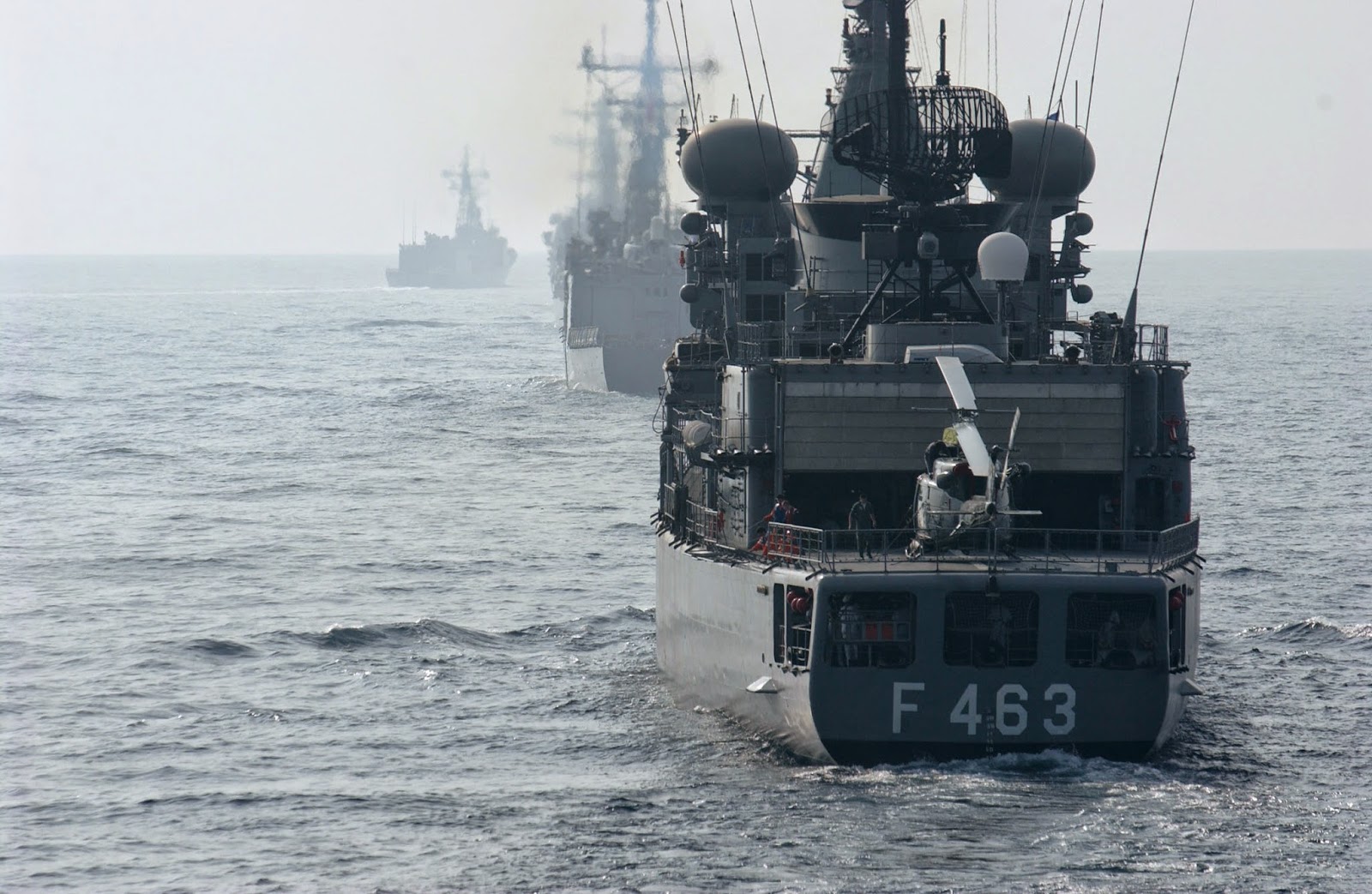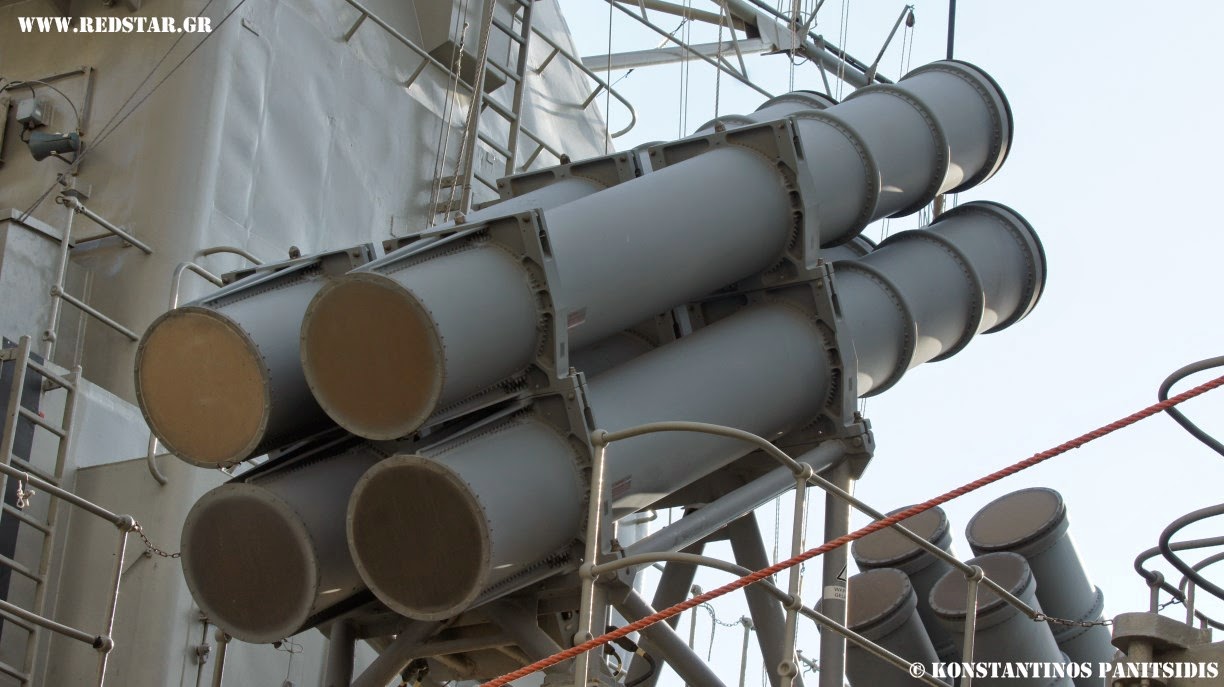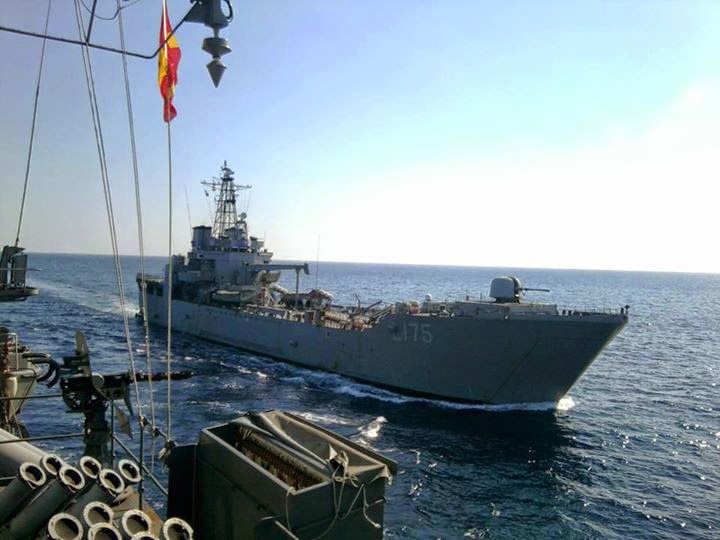Major Shaitan Singh
SENIOR MEMBER

- Joined
- Dec 7, 2010
- Messages
- 3,550
- Reaction score
- 43
- Country
- Location

Hellenic Navy Elli class frigates in formation
The Elli class of Hellenic Navy (Πολεμικό Ναυτικό) is a class of nine (9) general-purpose frigates. These are ex-Royal Netherlands Navy (Koninklijke Marine) Kortenaer-class frigates which are also known as Standard or S-class frigates. The name "Standard" came from the idea to pursue standardization within NATO fleet. Ten ships were built by the former Royal Schelde Dockyard (now Damen Schelde Naval Shipbuilding) and two by the former Wilton-Fijenoord (it has been acquired by Damen Shiprepair) between 1978 and 1983. A total of twelve S-frigates were built, two for Greece (frigates n.6 and n.7 during construction were sold to Greece, L-frigates replaced them) and ten for the Netherlands. Ultimately, of these ten Dutch ships, eight were sold to Greece and two to the United Arab Emirates. The Iranian Navy ordered eight modified ships from Royal Schelde but the contract was canceled after the Iranian Revolution. Together with the Jacob van Heemeskerck class (also known as L-class), an AAW variant of the Standard frigates, it was the largest Dutch naval shipbuilding project of the 20th century. Once, these frigates were the workhorses of the Royal Netherlands Navy, today they are the workhorses of the naval force of Greece.
Four Elli / Kortenaer class frigates of Hellenic Navy in formation.
The photo was taken from frigate Psara (F454)
Greece signed a contract with the Netherlands on September 1980 for the purchase of one Kortenaer class frigate that was under construction for the Royal Netherlands Navy. The option for a second frigate of the class was activated on June 1981. These were frigates Elli and Limnos, the most modern warships of Hellenic Navy that time. These ships were a valuable addition to the naval force of Greece due to their advanced electronics and weapon systems. On November 22, 1992, a second contract was signed with Netherlands for the transfer of three frigates that were in service with the Royal Netherlands Navy. The frigates Aegeon, Adrias and Navarino entered in service with Hellenic Navy the period 1993-1995 (see table for exact days). Kountouriotis was acquired in 1997 while the last four shipsBouboulina, Kanaris, Nikiforos Fokas and Themistocles entered in service with Hellenic Navy the period 2001-2003.

The ten Elli/Kortenaer class frigates in service with Hellenic Navy
The general characteristics of the class is a displacement of approximately 3,800tons at full load, length of 130.5m, beam of 14.6m, maximum speed of 30 knots and a range of 4,700n.m. with the speed of 16 knots. The crew is about 180 while the total capacity is 200 passengers. The propulsion is Combined Gas Or Gas (COGOG). It takes less than a minute to start the gas turbines, and within two minutes the ship is at full speed. The ships carry one medium helicopter which can be accommodated in a hangar.

Click to enlarge and save the image to view the details: modified photo of Elli/Kortenaer (Batch I) class frigate.
For a high resolution image click here.
In 1992, Netherlands offered the two L-class frigates to Hellenic Navy but the proposal was rejected due to the high cost of this sale according to the Greek side. In 2005 the two ships were sold to Chile which served until today. Chilean Navy replaced the DA05 tracking radar with SMART-S. This class of frigates will be analyzed thoroughly in another article.

L-class frigate of Chilean Navy. Photo: Damien Horvath
In the beginning of 2000, a discussion began on a possible modernization and upgrade of some of the ships of the class. Thales Nederland and Raytheon proposed the installation of a Raytheon 16-cell Mk48 Mod 1 Guided Missile Vertical Launching System (GMVLS) for 16 RIM-162C ESSM Surface to Air Missiles (SAMs) to one side of the hangar, a similar configuration with Karel Doorman class frigates. However, it was clear that the ship under this configuration could not guide many missiles against multiple missiles or to take advantage of the longer range of ESSM.
Thus, in the proposition was also included an option for a second Thales STIR 1.8 tracking and illumination radar system. Another option was to replace WM25 combined surface search/fire control radar and STIR 1.8 with a new APAR (Active Phased Array Radar) radar, the SEAPAR from Thales Nederland. However, the system was under development that time; besides the total cost of the new system and ESSM was very high and thus it was prohibiting the upgrade of more than two ships of the class. Thales Nederland proposed also to replace the front OTO Melara 76mm gun with two Mk41 modules (16 cells) for SM-2MR and ESSM missiles. In order to guide the SM-2MR the STIR 1.8 would had been upgraded to increase performance. The removed gun would had been installed atop of the hangar similarly with Batch II frigates and the Phalanx CIWS would had been installed where the Mk29 Sea Sparrow launcher is located. An option for a variant of SPY-3 was also proposed. All these proposals were rejected as they were considered very expensive.

Click to enlarge and save the image to view the details: modified photo of Elli/Kortenaer (Batch II) class frigate.

Frigate Navarinon prior the modernization.
Photo: Hellenic Navy
Finally, on February 12th, 2003, a contract of€381,575,580 was signed between General Directorate for Defense Investment and Armaments and Hellenic Shipyards (ENAE) for the mid-life modernization and overhaul of the six frigates of the Batch I and II. Thales Nederland was the main subcontractor and responsible for the total combat system integration, the delivery of new combat system equipment for the ships and sensors. The program began in July 2004 with frigate Kountouriotis; the sixth and last modernized frigate was delivered in 2009. The modernization emphasized on the electronic equipment and combat management system and left unchanged the weapon systems of the ships except for the addition of two Mk137 decoy launchers soft-kill weapon systems part of the BAE Systems SRBOC on Batch I frigates. That time, Batch I frigates were equipped with two units, similarly with frigates of the Batch III (Batch II frigates had already four launchers). Unfortunately, the significant upgrade of the Mk29 launcher to Mk29 Mod 4 in order to allow the launcher to launch the RIM-162 Evolved Sea Sparrow Missile (ESSM) was cancelled. The whole modernization program aimed to extend the frigates' service lives by 20 years. In summary, the modernization of the electronic equipment included the following:
- Addition of MIRADOR optronic observation and weapon control system (see extensive description of the sensors' capabilities in next paragraphs)
- Addition of SCOUT Mk2 LPI radar, a sensor that equips also the ships of the Batch III, while the old ZW06 surface search and navigation radar was removed
- Upgrade of WM25 combined surface search and fire control radar (see next paragraphs for an extensive description of the upgrade and the capabilities of the sensors)
- Upgrade of STIR 1.8 tracking and illumination radar
- Upgrade of LW08 long range air-search radar
- Installation of one of the most advanced systems in the world in this category, the EDO CS-3701 Electronic Support Measures (ESM); the old SPHINX is removed
- The Sewaco MkII combat management system is replaced with the advanced and very successful system in this category, the Thales TACTICOS (Sewaco FD).
- Installation of an ALEX system by Lockheed Martin Sippican's Passive Decoy Systems Group that links the decoy launching system to the ship's ESM, wind and navigation sensors.
- Replacement of the Integrated Communications System 3 (ICS3) by a new scheme of EADS Hagenuk
- Integration of the terminal data Link 11 from Rockwell Collins in the combat management system
- Installation of INMARSAT FLEET 77 on three ships
- Installation of two Marine Inertial Systems (INS) Mk39 Mod3A Ring Laser Gyro that replaced the gyro compasses Mk29 and Mk23
- Addition of GPS receiver
- Installation of V/UHF SATURN featuring Electronic Communications anti-Measure (ECCM
Many subsystems of the rest of the equipment such as parts of the propulsion system were replaced with new or other systems were upgraded to increase performance and capabilities. As it is already mentioned , for a more extensive description of the sensors' capabilities and details on the upgrades read these paragraphs that describe the electronic equipment of the ships.

Click to enlarge and save the image to view the details: modified photo of Elli/Kortenaer (Batch III) class frigate.
















































































